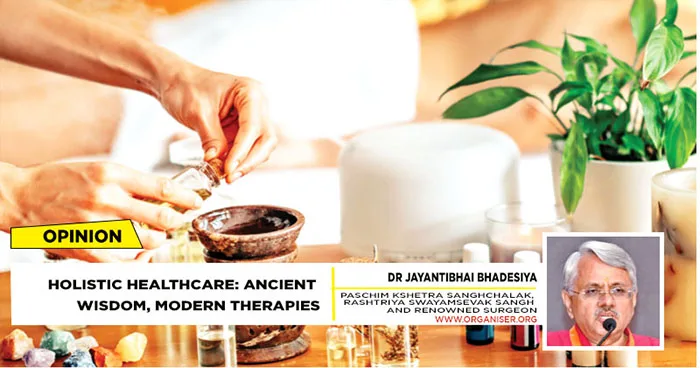There was a time when the basic necessities of man was limited to Roti, Kapda and Makaan— food to nourish, clothes to cover and a home to shelter. However, in the recent times, education and healthcare have been added to the list. Moreover, when debating healthcare, we often speak of a holistic approach to well-being.
In this great country called Bharat, it has been an age-old tradition to work together towards common causes. This idea has been invoked every now and then by men and Gods alike for causes cosmic and small. Such being the case, why should the discourse of holistic healthcare be left out of its ambit? After all, the motif sarve santu niramayaah or (may everyone live disease-free) continues to be a part of our everyday awareness and prayers.
To this end, RSS’s vision of working together and developing nation-minded Swayamsevaks can be instrumental. These inspired individuals, whichever field of professional or social sphere they choose to settle in, constantly think in terms of community’s well-being, and of working together. As no man is complete in oneself, unifying our strengths and skills is the only way to achieve fullness. The other great asset for us could be an organisation like Arogya Bharati, which is the umbrella organisation for numerous nationalist associations working towards healthcare in India. And then there is Arogya Pratisthan, too. Moreover, there are almost forty big hospitals in the country that share RSS’s ethics and values. Together, we can make a difference and realise what we call Susanskarit Swasthya Sewa. This vision of health services takes holistic view of all available resources and means to keep the entire society hale and hearty.
Embracing Holistic Healthcare
Bharat has been the home of numerous sciences of medicine and healthcare, the principal among which are Ayurveda and yoga. Ayurveda, in particular, commands the same sacred reverence as befitting a Veda. It is in fact, termed an Upa Veda. Revealed to mankind by Bhagwan Dhanvantri and divine Vaida Ashwini Kumar and furthered by the likes of Charak and Shushrut, it is perhaps the oldest known approach to holistic healthcare in the world. I say holistic because back in the day one did not need to visit a hospital or hospitalisation; the Vaida would come calling at one’s place of residence and administer medicines.
Moreover, Bharatiya knowledge of medicines was not divorced from other spheres of life or reduced to a specialised field inaccessible to most. There are examples of eminent Vaidya who were engaged in several common professions, including agriculture. According to the testimony of a British general, which was published in England, during the Tipu Sultan’s war against British, injured soldiers of Tipu’s army were rushed to nearby villages for treatment. And the persons treating them, in many instances, were common villagers with deep knowledge of medicine and therapy.
‘Modern’ Techniques in Ancient Bharat
These sciences of keeping man’s body and mind healthy and also curing the occasional lapse into sickness, have been in existence long before the Allopathic medicine and the modern hospitals came to India with the British. Dharampal, who studied England’s Gazetteers in order to understand British wisdom about Bharat during days of colonialism wrote Science and Technology in the 18th Century, a book that celebrates India’s prowess in the field of science. These accounts provide well-documented evidence of India’s medicinal prowess long before the advent of modern medicine.
In the modern world, medicine is administered through various forms. In some cases it’s injected directly into the bloodstream, another’s it’s taken orally or in the form of powder or fumes. It is not as if these techniques of treatment but unavailable to Indians. When Bakhtiyar Khilji came to India, he came down with a sickness which appeared incurable. When his hakim failed to treat him, someone advised him to reach out to a man called Rahul Bhadra in Nalanda. Khilji approached Rahul Bhadra and threatened him with beheading should the latter fail to cure him. Rahul Bhadra took up the challenge and asked Khilji to read Quran. Khilji had no problem reading a text which was secret to him. Two months later, Khilji returned to Ram Rahul Bhadra, completely cured of his ailment, and asked for the secret to his recovery. To Khilji’s great astonishment, Bhadra replied that he had coated the pages of the Quran with his medicine and that the occasional contact with his fingers and lips caused the medicine to enter his body, thereby curing him.
Integrating All Forms of Therapy
If we combine Bharat’s traditional sciences of the body and well-being—with its strong emphasis on preventive healthcare—with modern forms of medicine and create a space for the free exchange of knowledge, we can truly achieve holistic healthcare. After all new form of treatment is complete in itself and they’re all lacking in some respect or the other. For example, there are no cures for BP or liver ailments in allopathy, while Ayurveda can treat both of them completely. The tradition of surgery, likewise, is better developed in modern medicine. In Bharat, we never say no to knowledge. In this spirit of knowledge acquisition and exchange, if we bring together different from of healthcare and create an interdependent space for therapy, we can truly achieve holistic healthcare.
Our response to the COVID-19 virus is a testimony to the efficacy of the aforementioned approach. During the pandemic, all forms of medicine joined their forces and contributed to our response to the emergency. The Ayush ministry worked tirelessly to identify elements in our traditional systems of medicine and healthcare that can address the virus and minimise its adverse effect on the body.
Health care is a complex system that evolves over time. Therefore, it is imperative that the professionals involved in this field are not only trained in medical investigation and cure but also have management skills. The holistic approach should include not just methods of treatment but also approaches to making healthcare economical and affordable.


















Comments